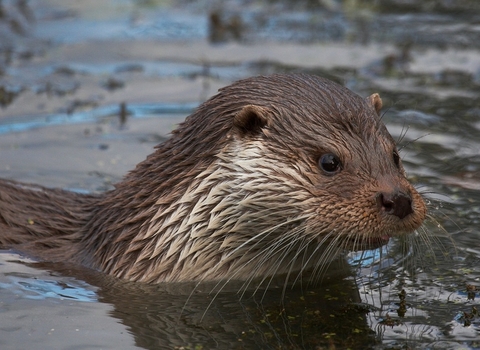
©Danny Green/2020VISION
European otter
Scientific name
Lutra lutraWhen to see
January to DecemberSpecies information
Category
Statistics
Length: 60-80cmTail: 32-56cm
Weight: 6-8kg
Average lifespan: 5-10 years
About
The elusive otter is one of our top predators, feeding mainly on fish (particularly eels and salmonids), waterbirds, amphibians and crustaceans. Otters have their cubs in underground burrows, known as 'holts'. Excellent and lithe swimmers, the young are in the water by 10 weeks of age. Otters are well suited to a life on the water as they have webbed feet, dense fur to keep them warm, and can close their ears and nose when underwater. They require clean rivers, with an abundant source of food and plenty of vegetation to hide their secluded holts.How to identify
The otter is a large, powerful mammal, with grey-brown fur, a broad snout, and a pale chest and throat. Otters can be distinguished from mink by their much larger size and broader face.Distribution
A rare but widespread species, now found throughout the country but absent from parts of central and southern England, the Isle of Man, the Isles of Scilly and the Channel Islands.In our area
After years of persecution - otters were traditionally hunted with hounds - and the polluting of the watercourses, otters almost disappeared from Shropshire completely. In recent years, they have started to recolonize, having spread eastwards from Wales. Like so many other wild animals, otters are hard to spot and it is usually a chance encounter if you are lucky enough to find one. However, there are a few otter "hotspots" around the county where occurrences of otters are becoming more frequent. And the locations are surprisingly urban; with otters being seen from bridges in Ludlow, Bridgnorth and Shrewsbury.
We are currently working with landowners across Shropshire to reduce agricultural and industrial pollution into our river systems. In addition to creating more habitat, it is essential that pollutants don't reach precious water supplies.
Did you know?
Seeing the signs of otters is far easier than seeing the animals themselves. Along riverbanks and waterways, look for five-toed footprints (about 6-7cm long) and droppings or 'spraints'. Otters leave spraints in prominent places, such as fallen trees, weirs and bridges, as 'scented messages', helping them to find mates and defend territories. They contain visible fish bones and have a distinctive, pleasant smell, reminiscent of jasmine tea!Watch
Otter by Russell Savory (https://vimeo.com/348139878)
Russell Savory
After years of persecution - otters were traditionally hunted with hounds - and the polluting of the watercourses, otters almost disappeared from Shropshire completely. In recent years, they have started to recolonize, having spread eastwards from Wales. Like so many other wild animals, otters are hard to spot and it is usually a chance encounter if you are lucky enough to find one. However, there are a few otter "hotspots" around the county where occurrences of otters are becoming more frequent. And the locations are surprisingly urban; with otters being seen from bridges in Ludlow, Bridgnorth and Shrewsbury.
We are currently working with landowners across Shropshire to reduce agricultural and industrial pollution into our river systems. In addition to creating more habitat, it is essential that pollutants don't reach precious water supplies.

